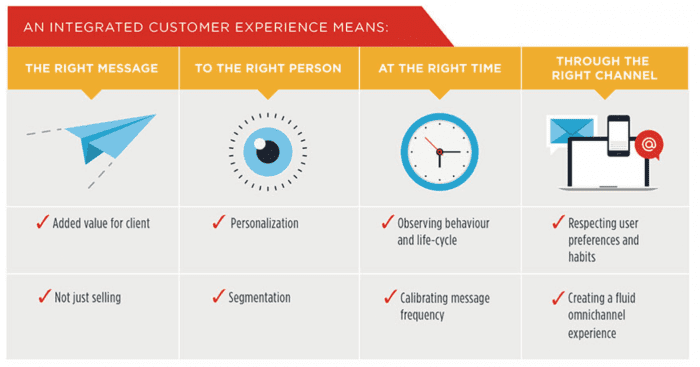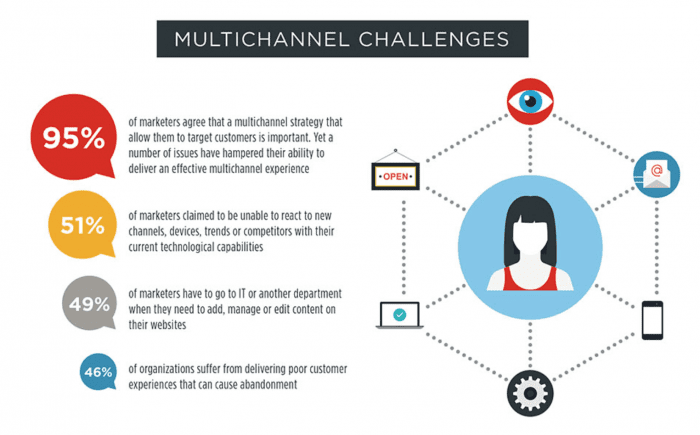Research reveals marketers approaches to multichannel marketing
In partnership with Digital Doughnut, EPiServer surveyed over 200+ marketers to find out how they are tackling multichannel marketing. The resulting report presents an overview of single-channel, multichannel and omnichannel strategies, as well as insights about how well marketers feel they are able to implement these strategies.
Below you will find some key findings from the report, as well as examples of companies who are successfully providing a more seamless experience for users.
Over the last five years, the way that brands are communicating with their customers has fundamentally changed. Instead of adopting a single-channel, or even multichannel approach, businesses must now offer a truly seamless experience across all devices. Rather than tailoring their approach to multiple individual touch-points, the latest digital marketers are breaking down these out-dated silos and are providing customers with a single coherent view of their brand - delivering the right message, at the right time, and to the right person. Due to its ‘omnipresent’ nature, this highly effective strategy has widely become known as ‘omnichannel marketing’.
While omnichannel marketing has been widely discussed within both the digital and ecommerce community, our new research suggests that many marketers still feel uncertain about their ability to offer a truly omnichannel approach. Although 95% of marketers agreed that some form of multichannel strategy is important for their organisation, only 39% felt they had the ability to recognise where a prospect was on the customer journey. In addition to this, 27% of marketers claimed to lack confidence in their ability to deliver “the right message, at the right time, to right prospect”.

From these statistics it is clear that while marketers want to benefit from an omnichannel strategy, they remain unsure of how to implement such a complex approach. This uncertainty is the result of three key hurdles in the marketing process:
1. The content conundrum
Faced with pressure from both customers and search engines to improve the quality of their content, marketers have found themselves in a Catch 22 scenario. For every significant improvement in content quality, the expectations of customers have shifted ever closer towards perfection. Customers also prefer to get their information through several channels, such as websites (80%), email (77%) and social media (58%). These expectations - combined with an ever-growing array of new platforms to develop on - are squeezing marketing budgets for everything they’re worth.
The average B2C businesses already use as many as six different types of content ranging from social media posts, articles, guides, videos to games within their marketing approach. For B2B brands, this figure jumps to 14! As this number grows, the ability to serve the right content across all touch-points becomes ever more unrealistic.
Getting past the conundrum
With all of these content types and channels available, one clear way to succeed is to get specific and personalize with your content. You can use marketing technology that makes it easy to optimise content across different channels based on each customer’s interests, needs and pain points. Take the example of apetito, a B2B catering provider who have recently streamlined their business and web content management process by serving only relevant content to specific markets. This not only helped to shorten the customer journeys and increase visitor dwell time by 89%, it also created a real content creation culture within the organisation.
2. The marketing technology disconnect
The oft-discussed “battle” between Marketing and IT is still raging on to this day, from ownership to operation. While marketing continues to own much of the digital debate (around 49% of decisions are made solely by marketing), a greater degree of collaboration is required to be a success. As it stands, only 42% of the marketing-driven technology decisions are being jointly made by both marketing and IT.
This lack of collaboration is having a significant impact upon their ability to deliver a smooth omnichannel experience. 51% of marketers claimed to be unable to react to new channels and devices due to out-dated tech, and almost half (49%) have to go to IT when they need to add, manage or edit content on their websites.
Connecting marketing and IT
To solve these common problems, multichannel clothing retailer Varner Group (owner of brands such as Bik Bok, Carlings, Volt) created a digital media team to bridge the gap between marketing and technology. The main focus of the team is the customer experience, and they are responsible for coordinating the requirements from front-end, back-end, design, UX to checkout optimization. Find out how the team works to quickly launch campaigns and new website features.
3. A deluge of data
In the age of big data analytics, marketers are flooded with information that could improve their services and ultimately turn potential prospects into long-term customers. Unfortunately, although the data exists, most marketers still don’t know how best to use it. For some, this is simply down to a lack of tools, with 36% of businesses still not using a CRM and 62% having no marketing automation tools in place.
As a result of this lack of data and understanding, 61% of marketers were unable to recognise where a prospect was on their customer journey and where to take them next.

Using data to engage diners
Pizza Hut Restaurants tackle this problem head on with tight integration between different platforms from their website, email, CRM, POS and booking engine. They create a single customer view, and use the customer data to engage diners on a 1-to-1 level. With location and profile data, they are able to send out highly targeted offers based on location, weather and time of day, as well as serving personalised content such as menu choices.
To find out more about what marketers are struggling with, and get tips on how to deliver a more seamless customer experience, read the ‘Multichannel Digital Marketing Report ’ published in 2015.
 Thanks to Youtse Sung for sharing their advice and opinions in this post. Youtse Sung is an experienced B2B technology marketer. She is currently the Sr. Manager, Global Programs at EPiServer, a global digital experience delivery platform, with responsibility for strategic planning, demand generation programs, product and digital content marketing. EPiServer are content partners of Smart Insights.
Thanks to Youtse Sung for sharing their advice and opinions in this post. Youtse Sung is an experienced B2B technology marketer. She is currently the Sr. Manager, Global Programs at EPiServer, a global digital experience delivery platform, with responsibility for strategic planning, demand generation programs, product and digital content marketing. EPiServer are content partners of Smart Insights.
You can follow her on Twitter or connect on LinkedIn.









